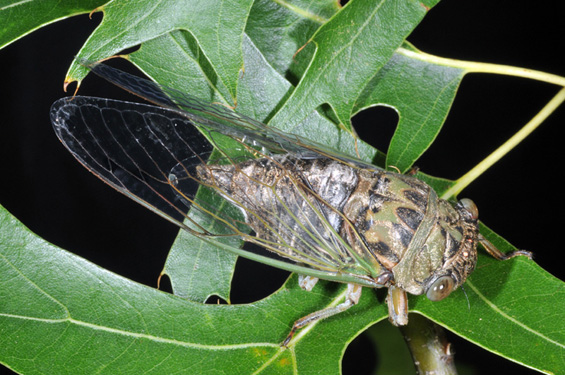
Common Name: Cicada
Scientific Name: Cicadidae: several species
Status: annoying; can damage young trees
Damaging Stage: adult
Biology: Two groups of cicadas, (periodical and annual) occur in many parts of the central and eastern United States. These are primarily nuisance pests, best known for the very loud, shrill, mating and congregation calls that they make as adults.
Periodical cicadas are 1- to 2-inches long and have black bodies and orange wing veins. Annual cicadas can be more than 2 inches long with very unique green or brown bodies and large eyes. Both have prominent wide-set eyes, short antennae, and clear wings held rooflike over the abdomen.
After mating, female cicadas cut slits into the tender bark of young twigs in which to lay their eggs. When the eggs hatch, the nymphs drop to the ground and bury themselves down into the soil until they find a tree root where they can attach and begin to suck out juices.
The major difference between the periodical and annual cicadas lies in the length of time that they live as nymphs. Annual cicadas have a one-year life cycle and emerge in early summer every year. Periodical cicadas may live 7, 13, or 17 years (depending upon the species) as nymphs and then they undergo a very well synchronized mass adult emergence. These emerge from the soil and climb onto nearby vegetation to molt into the winged adult stage.
Injury: When cicadas emerge in large numbers, they may leave significant numbers of unsightly cast skins on tree trunks, fence posts or the sides of structures. When there is a large emergence, the loud calls of the cicadas can be annoying and deafening. Mostly, however, real cicada damage occurs as a result of these insects killing small tree branches and twigs when they lay their eggs.
Action Threshold: Nursery trees, newly transplanted trees, and some fruit trees are most at risk for cicada damage. Assessing the vulnerability of the tree together with the anticipated cicada emergence will help determine the need for control.
Management: Small trees may be wrapped or netted to physically keep cicadas from laying eggs.
|